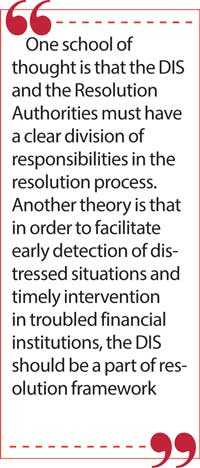Sunday Jan 05, 2025
Sunday Jan 05, 2025
Friday, 23 August 2019 00:00 - - {{hitsCtrl.values.hits}}

By Nishadi Thennakooon
During and after the global financial crisis, a number of countries established Deposit Insurance Schemes (DIS) with a view to preserving financial system stability.
The Central Bank of Sri Lanka (CBSL) commenced compensation payments to the depositors of two distressed licensed finance companies, namely the Central Investments and Finance PLC and Standard Credit Finance Ltd., in terms of the Sri Lanka Deposit Insurance and Liquidity Support Scheme (SLDILSS) in 2018. The coverage per-depositor per-institution was increased from Rs. 300,000 to Rs. 600,000, with effect from January 2018. 
There is a perception that shutting down all fragile financial institutions after making compensation payments under a DIS would resolve systemic problems. It is also observed that the awareness of the general public regarding the benefits and limitations of a DIS, which functions as one of the safety net mechanisms in the financial system, is very limited. This article is an effort to fill that awareness gap in society.
What is deposit insurance?
Deposit insurance is considered a guarantee that depositors’ money with a financial institution will be honoured in the event of the collapse of the entity. In general, deposit insurance is an undertaking that all or a limited amount of the principal and interest accrued on such deposits will be paid in the event of a failure of a financial institution. The rationale behind the deposit insurance schemes worldwide is protecting less sophisticated small savers.
The importance of deposit insurance
Banks and other financial institutions are engaged in an inherently risky business. Failure of a large number of financial institutions will lead to erode public confidence in financial systems. It will then hamper funding flows to financial institutions. Financial intermediation, the lifeblood of the economy, will not be successful if financial institutions do not lend to deficit units in the system. The adverse impact of such a behaviour will lead to lost investments, lost output, and increased unemployment.
A DIS, therefore, plays a role in achieving the public policy objectives of promoting economic growth, generating employment and achieving financial system stability. DISs contribute to enhance public trust in financial systems by giving assurances to the people regarding the protection of their deposits.
DIS is also considered as a part of the financial safety net. DISs are intended to contribute to financial system stability by protecting the system against bank runs (these occur particularly on solvent banks) and ensuring the safety and liquidity of the deposits of small depositors. When depositors have faith in the banking system, the tendency to have panic among them will be reduced.
Diamond and Dybuig (1983) state, if depositors believe that there will be no run, then only investors with real liquidity needs withdraw their money, and the bank is able to meet such demands without costly liquidation of assets. Therefore, the contagion risk faced by the financial system can be mitigated through a DIS.
During the global financial turmoil in 2008 the deposit insurance coverage in the US and many other countries were expanded. It helped to prevent a collapse in consumption, even though there was a severe economic downturn. It is in this sense that deposit insurance proved its usefulness during a crisis.
Features of an effective DIS
In 2009, the International Association for Deposit Insurance (IADI) introduced the core principles for an effective DIS.
According to the said principles, a sound banking sector, strong prudential regulation, supervision and resolution, an efficient legal and judicial framework, as well as accounting and disclosure framework are preconditions for an effective regime. It is, therefore, important that supervisory authorities of financial institutions have close coordination with DIS. In Sri Lanka, the CBSL supervises most of the financial entities and the SLDILSS is also at present managed by the Resolution and Enforcement Department of the bank. Since the goals of prudential supervision and deposit insurance reinforce each other, it can be argued that carrying out both the functions by a single entity, with appropriate checks and balances, would be a prudent arrangement. In terms of the IADI principles, sound funding arrangements are critical to the effectiveness of a DI system. When several financial institutions are facing distressed situations simultaneously, there can be costly delays in resolving them. Such delays may erode the public confidence in the financial system. Hence, the Deposit Insurer needs to be enabled to plan paying out of the deposits expeditiously.
However, there must also be caution, particularly when the Fund is not a significantly large one. Suspending businesses of several financial institutions within short intervals will lead to panic resulting in the depositors withdrawing their money from sound institutions as well. This leads to liquidity problems even in healthy institutions.
In the absence of an assurance of receiving their money back, people are likely to become reluctant to deposit their funds in financial institutions. In such a situation, the economic growth momentum would also be hampered due to lower supply of credits to economic activities.
According to IADI principles, the key public policy objectives of DIS need to be protecting depositors and contributing to financial stability. These objectives need to be publicly disclosed. The ability to function in an operationally independent manner and the need to have transparency and the accountability are emphasised as key elements of governance of a DIS.
The need to have efficient and effective coordination between key organisations, such as the financial regulator, Ministry of Finance and the Deposit Insurance Authority is also highlighted under IADI principles. With financial institutions becoming more globally interconnected, it will also be important to strengthen the cross border deposit insurance policies.
The EU has created a DIS under a single resolution mechanism. Wherever in the Europe, a depositor of a member state lives, the European DIS protects him/her. Pooling of resources has made handling large shocks and financial crises easier than having recourse to public money at individual member state levels. In the US, DIS has been in use since the early 1800s. The Federal Deposit Insurance Corporation (FDIC) was incorporated in 1933 during the Great Depression period. However, such establishments have not been able to prevent occurrence of financial crises.
Japan established the Deposit Insurance Corporation of Japan in 1971, as a separate national agency with a mandate to protect depositors. In India, deposit insurance was started with the launch of the Deposit Insurance Corporation and Credit Guarantee Corporation (DICGC) of India in 1961. It is fully owned by the Reserve Bank of India.
Main types of DIS
DISs are mainly divided into two categories i.e. explicit or implicit. According to Kent and Kane (2006), the explicit deposit protection coverage is a contractual obligation whereas the implicit coverage is only conjectural and exists to the extent political incentives influence a government’s reaction to large or widespread banking problems. 
The Sri Lankan DIS is an explicit deposit insurance model. Under an explicit DIS, key aspects such as coverage limits, funding mechanism, compensation procedure and members are specific. The explicit DIS does not create uncertainty and it enhances public confidence as well.
However, scholars argue that this will lead to moral hazard as explicitly protected depositors may have less incentive to monitor their financial institutions. It is observed that in Sri Lanka, the depositors generally commence monitoring the performances of a financial institution only after the particular entity is in distress. It is important to have the vigilance of the depositors too in tandem with the supervision of the regulatory authorities.
There are several mandates under the explicit deposit insurance scheme. According to the ‘Pay box’ mandate, the insurers have narrow empowerment and it is limited to facilitate payment of claims to depositors. In this scenario, deposit insurance authority is only responsible for the reimbursement of insured deposits. At present, Sri Lanka has a pay box mandate. In terms of the ‘Pay box plus’ mandate, the deposit insurer has extra responsibilities such as a resolution function.
One school of thought is that the DIS and the Resolution Authorities must have a clear division of responsibilities in the resolution process. Another theory is that in order to facilitate early detection of distressed situations and timely intervention in troubled financial institutions, the DIS should be a part of resolution framework. Early detection of problems in financial institutions will mitigate the risk faced by DIS too.
As stated by Carstens (2018), the availability of a wide array of tools for the deposit insurer will be vital in resisting political economy pressures to keep insolvent institutions afloat. It has been observed that, in Sri Lanka, distressed companies have been allowed to exist in the system for lengthy periods due to such political influences. When this happens, moral hazard too increases. It is, therefore, important to have a comprehensive special resolution regime for banks and licensed finance companies, in Sri Lanka, to implement DIS effectively.
However, in designing the mandate of the deposit insurance authority, country specific circumstances, such as the powers and capacities of the regulator, excising legal framework and the nature of the financial system etc. need to be considered extensively. The CBSL is in the process of bringing a new law to include, inter alia, a comprehensive Deposit Insurance function in to the regulatory remit of the bank. The potential incentive conflicts should also need to be avoided in deciding the architecture of DISs.
The Federal Deposit Insurance Corporation (FDIC) has a broad array of powers including both supervisory oversight and resolution. In some jurisdictions, there are integrated DISs which provide a wide scope to protect insurance policyholders, stock exchange investors and non-bank financial institutions, in addition to the banks.
There is another mandate named ‘loss minimiser’ where the insurer selects from a range of least cost resolution strategies. In terms of the risk minimiser mandate, the insurer has a wide scope of activities such as early intervention and resolution powers. It is a comprehensive risk minimisation function.
Minimising ‘opportunity cost’ of money
In terms of a study (Karan Gulati etal 2019) carried out regarding deposit the insurance scheme of India, the standard measure for the impact of the delayed payment is the ‘opportunity cost’ of the money. In the event of a failure of a financial institution, deposit insurance will have to reduce the pay-out time to minimise opportunity cost of money for the depositors.
In order to enable deposit insurance to ensure timely reimbursements of insured deposits, all licensed financial entities must maintain relevant systems and records accurately. In the absence of accurate data bases of depositors the repayment process gets delayed as there is no operational readiness and the opportunity cost to the depositors rises. It is observed that delays can also occur, when the depositors have not named nominees, failed to record the names properly and when the claimant does not submit all required documents.
The depositors should also be aware of these issues and provide accurate information when the deposits are made. Such enhanced awareness would improve the efficiency of the DIS in Sri Lanka, and minimise the opportunity cost for the depositors.
Striking a balance between moral hazard and deposit insurance
In theory, the absence of an explicit deposit insurance may compel depositors and creditors to monitor banks and exert market discipline. However, it can be argued that such approach depends on the level of financial literacy of the people.
Therefore, expecting the people (particularly individual small depositors) to discourage aggressive risk-taking by banks and other financial institutions is not at all very practical. However, large corporate depositors can play a significant role in monitoring their banks.
Another argument is that when funding of the deposit insurance comes through premiums levied on the member institutions based on the risk they take, there can be a deterrence against taking aggressive risks. The application of differential premiums depending on the risks financial institutions are taking can also reduce the effect of moral hazard. Some schemes collect funds on an ex-ante basis and some jurisdictions have ex-post or unfunded schemes. There are hybrid approaches i.e. a combination of ex-ante and ex-post funding methods as well. Scholars argue that ex-post mechanisms discourage moral hazard. The advantage of ex-ante funding compared to ex-post arrangement is the possibility of avoiding delays in compensations. An ex-ante funding system contains an anti-cyclical feature and buffer for the industry, as the premiums are collected during the time sound economic conditions are prevailed. Another argument is that ex-post system is less burdensome during periods when there are no or few failures because premiums are not being collected continually.
When the premium paid by member institutions is risk-based such entities are compelled to avoid engaging in excessively risky activities. However, the practical difficulties of introducing risk-based premiums should also be acknowledged. Furthermore, when the membership is not mandatory, weak entities will be attracted by the scheme while large sound entities might find DIS is not beneficial to them. However, in Sri Lanka, there is a mandatory scheme. In considering paying off depositors of failed finance companies, one must also take into account the concerns of large healthy institutions whose contributions have made the funding base of the DIS broader and more reliable.
The other side of the argument is that large healthy entities will also be benefitted when the depositors of fragile institutions are settled as it helps to boost public confidence in the entire financial system. Every financial institution, irrespective of size and soundness can reap benefits from a resilient system.
Deposit insurance is not the only solution for financial system stability
In order to have a smooth fabric of financial system stability, all the key components need to be woven carefully. If the regulatory and supervision framework is robust, prompt corrective actions against the malpractices of financial institutions can be implemented effectively.
Prudential regulation can also give an assurance that deposit insurance schemes are called on only rarely. The macro prudential surveillance capability of the regulator will help to detect systemic threats. The proposed Monetary Law Act will, therefore, need to empower the Central Bank to carry out such macro prudential surveillance. It should also be emphasised that depositors too have a role to play in ensuring the resilience of the system.
In Sri Lanka, depositors also aid and abet the violations by accepting extremely high unsustainable interest rates. It is observed that such unsustainable interest rates offered by licensed finance companies, in contravention of rules and regulations of CBSL, have caused liquidity crises in such institutions. Additional monitoring carried out at least by large depositors will restrict excessive risk taking by financial institutions.
While the regulators ensure financial institutions are subject to prudent norms and practices, the Board of Directors and key management personnel of those entities are responsible to uphold corporate governance and compliance standards.
Strengthening the deposit insurer with resources and resolution tools will be important in minimising the cost to the deposit insurance fund and maximising value for creditors. As suggested by the IADI, estimating the empirical frequency distribution of losses will help to determine the target deposit insurance fund.
The political decisions taken during crisis may not always be prudent decisions ones which will ensure the long run interest of a sound and safe financial system. The independence of the deposit insurance authority will enhance the credibility of the scheme and increase its capacity to resist such pressures.
Making the Central Bank of Sri Lanka an autonomous body under the proposed Monetary Law Act will, therefore, be important in upholding the credibility of the deposit insurance scheme of Sri Lanka. An efficient and effective resolution mechanism needs communication and better coordination among regulators, resolution authorities and deposit insurers.
The proposed law which will empower the CBSL to function as the resolution authority will facilitate the appropriate balance between the functions of the Bank as the apex financial regulator and the deposit insurer.
The rapidly-evolving technological developments should also be taken into account in designing the scope of a DIS. In the context of complex banking products being introduced by fintech entities, the scope of deposit insurance will have to be flexible to respond constructively yet prudently to such innovations.
Mere pay-outs to traditional depositors will challenge the relevance of a DIS in the modern financial world. However, the deposit insurance should not be a mechanism to incentivise excessive risk taking by financial institutions.
A sound risk management framework adopted by individual financial institutions including, an entity specific resolution plan, will also help to preserve systemic stability. Enhanced awareness of the general public on the benefits and limitations of the deposit insurance system is also very vital in promoting the credibility of a DIS. Deposit insurance without market discipline will increase the costs and pain of resolving a financial crisis.
(The writer, a Deputy Director, CBSL, Attorney-at-Law, can be reached at [email protected]. The views and opinions expressed in this article are those of the writer and do not necessarily reflect the official policy or position of any institution.)